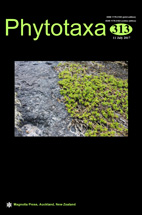Abstract
A survey of saprobic fungi yielded two new ascomycetes, Dyfrolomyces maolanensis and D. thamplaensis, which were isolated from dead branches collected from karst landforms of China and Thailand respectively. Both of them are characterized by immersed, clypeate, papillate ascomata, long cylindrical, short-pedicellate asci and fusiform, guttulate, 3-septate ascospores. Molecular analysis of combined LSU, SSU and TEF1-a sequence data placed them in the family Dyfrolomycetaceae with good support. Morphologically, they differ from other species of Dyfrolomyces by their ascospores, which are normally 3-septate, fusiform with acute or angular ends. And those reported Dyfrolomyces species were collected aquatic habitats, while our new species in this study were collected from terrestrial habitats. Saccardoella aquatica shares the similar morphology with these two new taxa, but can be distinguished in having its smaller asci and ascospores. Therefore, we introduce D thamplaensis and D. maolanensis here as new species and also transfer S. aquatica to Dyfrolomyces based on its similar morphological characters, as well as the molecular evidence of above two new taxa.

